Iceland travel is an adventure of a lifetime, but planning is key! SIXT.VN offers comprehensive travel advice and booking services, ensuring a smooth and unforgettable trip to this stunning Nordic nation. Let’s discover the most important things to know before your journey.
1. Embracing Iceland’s Unpredictable Weather
Is it true that Iceland weather is unpredictable? Yes, Iceland’s weather is incredibly changeable. The saying “there’s no bad weather, only unsuitable clothing” is particularly relevant here. Be prepared for anything! Pack layers of warm clothing, waterproofs, and sturdy hiking boots, no matter the time of year. A good quality tent is essential if you plan to camp.
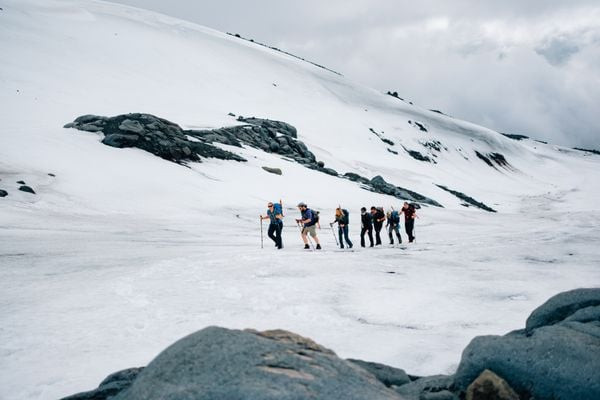 Expect snow at any time of year in Iceland, especially at higher altitudes. Photo: Tom Barker.
Expect snow at any time of year in Iceland, especially at higher altitudes. Photo: Tom Barker.
1.1. Understanding Iceland’s Climate
Iceland’s climate is classified as subpolar oceanic. This means cool summers and mild, windy winters. The Gulf Stream makes the temperatures relatively warmer than other places at similar latitudes. Coastal areas generally have milder temperatures than the highlands. Weather changes rapidly, so it’s not unusual to experience sunshine, rain, and even snow in a single day.
1.2. Dressing Appropriately for All Seasons
Layering is crucial due to the fluctuating temperatures. Start with a moisture-wicking base layer, add insulating layers like fleece or wool, and top it off with a waterproof and windproof outer shell. Don’t forget warm hats, gloves, and scarves, even in summer. Sturdy, waterproof hiking boots are essential for exploring Iceland’s rugged terrain.
1.3. Resources for Checking the Weather Forecast
Stay updated on the weather forecast using reliable Icelandic websites and apps. Vedur.is is the official source for weather information in Iceland, providing detailed forecasts and warnings. Belgingur.is offers weather maps and real-time data. These resources help you plan your activities safely and make informed decisions.
2. Experiencing Iceland’s Stark Beauty
Does Iceland’s beauty endure regardless of weather? Absolutely, Iceland’s stark beauty persists in all weather conditions. Its otherworldly landscapes, shaped by volcanic activity and glacial forces, are truly captivating. Driving the Ring Road (Route 1) offers stunning views of glaciers, lava fields, fjords, and volcanic mountains. Variable weather only enhances the allure, creating dramatic scenes that are perfect for photography.
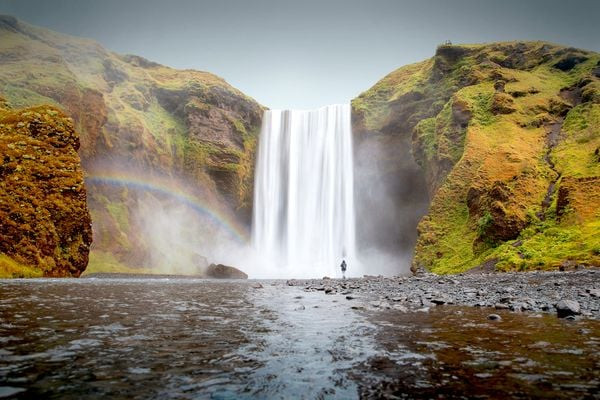 Skogafoss, Iceland.
Skogafoss, Iceland.
2.1. Exploring Iceland’s Diverse Landscapes
Iceland is a land of contrasts, with diverse landscapes ranging from glaciers to black sand beaches. Vatnajökull, Europe’s largest glacier, is a must-see, offering ice caves and glacier hiking opportunities. The black sand beach of Reynisfjara is famous for its basalt columns and dramatic waves. Geothermal areas like Geysir and Hverir showcase Iceland’s volcanic activity with geysers and bubbling mud pools.
2.2. The Allure of Iceland’s Variable Weather
The ever-changing weather conditions add to Iceland’s charm. Storms breaking out at sea and moving along the coast create dramatic displays of nature’s power. Snow-covered landscapes offer a monochromatic contrast that’s both beautiful and haunting. Rainy days can intensify the colors of the landscape, making the moss-covered lava fields appear even more vibrant.
2.3. Must-Visit Locations for Photography
Iceland offers endless photographic opportunities. Kirkjufell mountain and its nearby waterfalls are iconic subjects. The Jökulsárlón glacier lagoon, with its icebergs floating towards the sea, is a photographer’s dream. The Northern Lights, visible during the winter months, provide a magical and unforgettable experience. Capture the unique beauty of Iceland’s landscapes and weather phenomena.
3. The Laugavegur Trek: Guided vs. Independent
Is it easier to do the Laugavegur Trek independently? Trekking the Laugavegur independently requires carrying all your own food and gear, making it challenging. Guided groups enjoy the luxury of lighter packs and delicious meals.
 A guided group on the Laugavegur trek. Photo: Icelandic Mountain Guides.
A guided group on the Laugavegur trek. Photo: Icelandic Mountain Guides.
3.1. Challenges of Independent Trekking
Independent trekking on the Laugavegur involves carrying heavy backpacks with food, camping equipment, and clothing. Rationing food and water is essential, and meals often consist of energy bars and dehydrated food. Weather conditions can be unpredictable, making the trek even more demanding. Navigation is generally straightforward, but hikers should be prepared for river crossings and challenging terrain.
3.2. Benefits of Guided Tours
Guided tours offer a more comfortable and enjoyable experience. Guides take care of logistics, including transportation, accommodation, and meals. Hikers carry lighter packs, allowing them to focus on the scenery and enjoy the trek. Guided tours also provide valuable information about the local flora, fauna, and geology. Group camaraderie enhances the experience, making it more social and fun.
3.3. Options for Experienced Hikers
Experienced hikers can consider fastpacking the Laugavegur, completing the 35-mile route in two or three days. This requires a high level of fitness and careful planning, but it allows hikers to experience the trek’s beauty in a shorter time. Alternatively, joining a guided tour offers a balance of independence and support, allowing hikers to enjoy the trek without the stress of logistics.
4. Iceland’s Geothermal Pools: Local vs. Blue Lagoon
What are the benefits of local geothermal pools compared to the Blue Lagoon? Local geothermal pools offer a more authentic and affordable experience than the Blue Lagoon. These pools are deeply ingrained in Icelandic culture, serving as social hubs where locals gather to relax and chat.
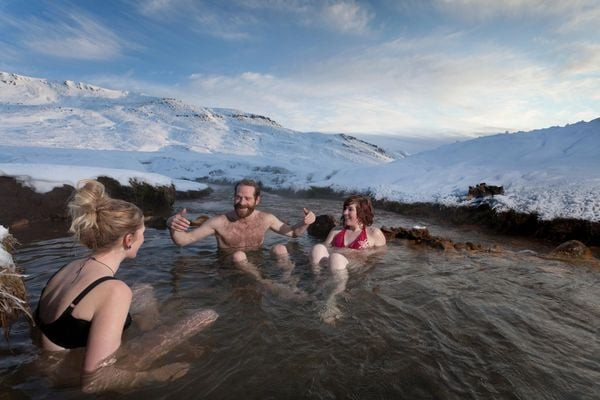 Socialising in one of Iceland
Socialising in one of Iceland
4.1. The Blue Lagoon Experience
The Blue Lagoon is Iceland’s most famous geothermal spa, known for its milky blue water and luxurious amenities. It attracts large crowds and can be quite expensive. While the Blue Lagoon offers a unique and relaxing experience, it’s not representative of Iceland’s local pool culture.
4.2. Discovering Local Swimming Pools
Local swimming pools are an integral part of Icelandic life. They’re typically equipped with indoor and outdoor pools, hot tubs (heitir pottar), and saunas. These pools are geothermally heated, providing a natural and relaxing experience. Visiting local pools offers a chance to socialize with Icelanders and learn about their culture.
4.3. Cultural Significance of Icelandic Pools
Swimming lessons have been compulsory in Iceland since 1940, reflecting the nation’s connection to the sea. Pools serve as community centers where people of all ages gather to exercise, relax, and socialize. The hot tubs are particularly popular for conversations and catching up with friends. Experiencing Iceland’s local pool culture provides a unique and authentic glimpse into Icelandic society.
5. Cutting Transport Costs with Carpooling
Is carpooling a viable transport option in Iceland? Yes, carpooling is a cost-effective and environmentally friendly way to travel in Iceland. While renting a car is a popular option, it can be expensive for solo travelers. Public transportation is limited outside of Reykjavik and the southwest.
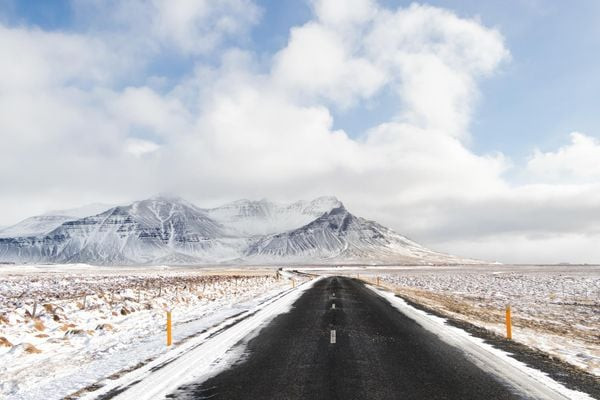 Roads in Iceland. Photo: Getty.
Roads in Iceland. Photo: Getty.
5.1. Drawbacks of Renting a Car
Renting a car provides flexibility and convenience, but it can be costly, especially for solo travelers. Rental rates, insurance, and fuel expenses add up quickly. Driving on Iceland’s gravel roads requires caution and can damage vehicles, leading to additional costs. Parking in Reykjavik can also be expensive and challenging.
5.2. Navigating Iceland’s Public Transportation
Iceland has a public bus system, but services are limited outside of Reykjavik and the southwest. Buses are less frequent and may not reach remote areas. Planning your itinerary around bus schedules can be time-consuming and restrictive. Public transportation is a viable option for budget travelers, but it requires patience and flexibility.
5.3. Using Carpooling Websites and Hostels
Carpooling websites like Samferda.net connect travelers with drivers heading in the same direction. Petrol costs are split among passengers, making it a budget-friendly option. Many hostels have boards where travelers can share or advertise lifts. Carpooling offers a chance to meet locals and fellow travelers while reducing transportation costs.
6. Local Cuisine: A Culinary Adventure
What are some must-try Icelandic foods? Embrace the local cuisine by trying traditional dishes like lamb soup, fresh seafood, and skyr. While some Icelandic foods might be unusual, they offer a unique cultural experience. And avoid fish oil for breakfast; you’ve been warned!
 Icelandic breakfast, including fish oil shots. Photo: Icelandic Mountain Guides.
Icelandic breakfast, including fish oil shots. Photo: Icelandic Mountain Guides.
6.1. Traditional Icelandic Dishes
Icelandic cuisine is characterized by fresh, locally sourced ingredients. Lamb is a staple, often served in hearty soups and stews. Seafood is abundant, with fresh fish and shellfish available in coastal towns. Skyr, a traditional Icelandic dairy product similar to yogurt, is a popular breakfast item and dessert.
6.2. Avoiding Fish Oil for Breakfast
Lýsi, or cod liver oil, is a traditional Icelandic health supplement. While it’s rich in vitamins and omega-3 fatty acids, its pungent taste can be off-putting, especially first thing in the morning. It’s best to avoid it unless you’re prepared for a strong, fishy flavor.
6.3. Embracing Unique Culinary Experiences
Iceland offers a range of unique culinary experiences. Try traditional dishes like hákarl (fermented shark) and svið (singed sheep’s head) for a taste of Icelandic history. Visit local markets and food festivals to sample regional specialties. Be open to trying new things and exploring Iceland’s diverse culinary landscape.
7. Budget-Friendly Food Options in Iceland
What are the best budget-friendly food options in Iceland? Opt for affordable options like hot dogs and soup to save money on food. Hot dogs are a local favorite and a cheap and tasty meal. Many restaurants offer daily soup specials that are both hearty and affordable.
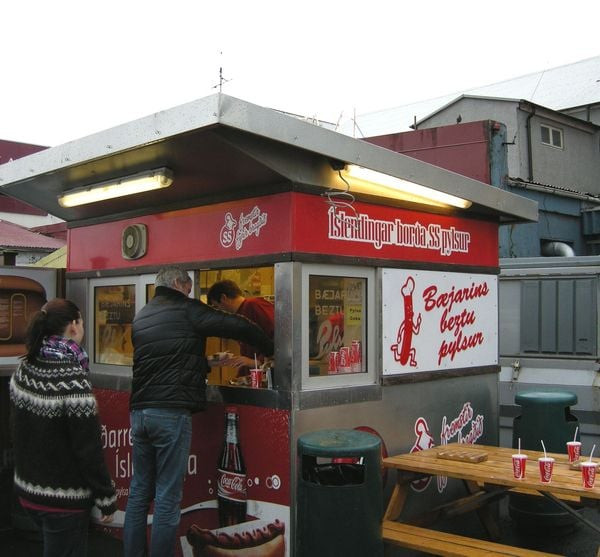 Bæjarins Beztu Pylsur, Reykjavik's most famous hot dog stand. Photo: Wikimedia Commons.
Bæjarins Beztu Pylsur, Reykjavik's most famous hot dog stand. Photo: Wikimedia Commons.
7.1. Reykjavik’s Expensive Dining Scene
Reykjavik is known for its expensive dining scene. Eating out at restaurants can quickly drain your budget. To save money, consider cooking your own meals or opting for more affordable options.
7.2. Hot Dogs: A Local Favorite
Hot dogs are a popular and budget-friendly meal in Iceland. Bæjarins Beztu Pylsur in Reykjavik is the most famous hot dog stand, serving up delicious lamb-based hot dogs with unique toppings. You’ll find hot dog stands in nearly every town you visit.
7.3. Soup: A Hearty and Affordable Option
Many Icelandic restaurants offer a daily soup option, which is a great choice for budget travelers. Icelandic soups tend to be hearty and flavor-packed, such as kjötsúpa (lamb soup) and humarsúpa (langoustine soup). These soups are both filling and delicious, providing a warm and satisfying meal after a day of exploring.
8. Essential Tips for Your Iceland Adventure
Before embarking on your Iceland adventure, here are some essential tips to keep in mind:
8.1. Plan Your Itinerary Carefully
Iceland offers so many incredible sights and experiences that it’s easy to feel overwhelmed. Start by researching the destinations that appeal to you most, such as the Golden Circle, the South Coast, or the Snaefellsnes Peninsula. Consider the amount of time you have available and prioritize the attractions that align with your interests.
8.2. Book Accommodation and Tours in Advance
Iceland has become an increasingly popular tourist destination, especially during the peak summer months. To secure your preferred accommodation and tours, it’s best to book well in advance. This will not only give you peace of mind but also potentially save you money, as prices tend to increase closer to the travel date.
8.3. Respect Icelandic Nature and Culture
Iceland’s natural landscapes are fragile and require careful preservation. When exploring, stick to marked trails, avoid littering, and be mindful of the local flora and fauna. Show respect for Icelandic culture by learning a few basic phrases, being polite to locals, and following local customs.
9. Navigating Iceland’s Challenges
While Iceland offers a wealth of incredible experiences, it’s important to be aware of some potential challenges:
9.1. High Cost of Living
Iceland is known for its high cost of living, which can impact your travel budget. Accommodation, food, transportation, and activities all tend to be more expensive than in many other countries. Plan your finances accordingly and look for ways to save money, such as cooking your own meals or taking advantage of free activities like hiking.
9.2. Unpredictable Weather Conditions
Iceland’s weather can be notoriously unpredictable, with conditions changing rapidly and unexpectedly. Pack layers of clothing to adapt to varying temperatures and weather patterns. Check the weather forecast regularly and be prepared to adjust your plans if necessary.
9.3. Limited Daylight Hours in Winter
During the winter months, Iceland experiences very short daylight hours, which can limit your ability to explore. Plan your activities accordingly and consider focusing on attractions that are illuminated or easily accessible in the dark. The Northern Lights are a major draw during winter, so take advantage of the long nights to search for this incredible natural phenomenon.
10. Essential Icelandic Phrases for Travelers
Learning a few basic Icelandic phrases can enhance your travel experience and show respect for the local culture:
| Phrase | Icelandic | Pronunciation |
|---|---|---|
| Hello | Halló | Hah-lo |
| Goodbye | Bless | Bless |
| Thank you | Takk | Tahk |
| Please | Vinsamlegast | Vin-sahm-leh-gast |
| Yes | Já | Yow |
| No | Nei | Nay |
| Excuse me | Afsakið | Ahf-sah-kith |
| How much does it cost | Hvað kostar þetta | Kvath kohs-tar thet-ta |
| Where is…? | Hvar er…? | Kvar air…? |
FAQ: Travel Iceland
What is the best time to travel to Iceland?
The best time to visit Iceland depends on your priorities. Summer (June-August) offers long daylight hours and pleasant weather for hiking and exploring. Winter (November-March) is ideal for seeing the Northern Lights and experiencing Iceland’s winter landscapes. Spring and Fall provide a balance of milder weather and fewer crowds.
How many days do I need in Iceland?
A week is generally recommended to explore Iceland’s major attractions, such as the Golden Circle, the South Coast, and Reykjavik. However, a longer trip of 10-14 days allows you to venture further afield and explore the Westfjords or the Snaefellsnes Peninsula.
What is the currency in Iceland?
The currency in Iceland is the Icelandic króna (ISK). Credit cards are widely accepted, but it’s a good idea to carry some cash for smaller establishments and remote areas.
Do I need a visa to visit Iceland?
Iceland is part of the Schengen Area, which allows citizens of many countries to visit without a visa for up to 90 days. Check the visa requirements for your nationality before traveling.
What are some must-see attractions in Iceland?
Must-see attractions in Iceland include the Blue Lagoon, the Golden Circle (Geysir, Gullfoss, Þingvellir National Park), the South Coast (Seljalandsfoss, Skógafoss, Reynisfjara), Jökulsárlón glacier lagoon, and the Northern Lights.
What should I pack for a trip to Iceland?
Pack layers of warm clothing, including a waterproof and windproof outer shell, fleece or wool sweaters, thermal underwear, hats, gloves, and scarves. Sturdy hiking boots are essential for exploring Iceland’s rugged terrain. Don’t forget swimwear for visiting geothermal pools.
Is it safe to drink tap water in Iceland?
Yes, tap water in Iceland is clean, safe, and delicious. You can drink it directly from the tap.
What is the best way to get around Iceland?
Renting a car is the most popular way to get around Iceland, providing flexibility and convenience. Public transportation is limited outside of Reykjavik and the southwest. Carpooling is a cost-effective alternative for solo travelers.
Are the Northern Lights always visible in Iceland?
The Northern Lights are visible in Iceland during the winter months (September to April), but visibility depends on weather conditions and solar activity. Clear, dark nights offer the best chances of seeing the Aurora Borealis.
What are some popular activities in Iceland?
Popular activities in Iceland include glacier hiking, ice caving, whale watching, Northern Lights hunting, hiking, visiting geothermal areas, and soaking in hot springs.
Ready to Explore Iceland?
Don’t let the challenges deter you from experiencing the magic of Iceland. With careful planning and the right resources, your trip can be smooth and unforgettable. SIXT.VN offers a range of services to help you plan and book your Iceland adventure, including personalized itineraries, airport transfers, hotel bookings, and guided tours.
Ready to embark on your Iceland journey? Contact SIXT.VN today to start planning your dream trip. Visit our website at SIXT.VN or call our hotline/Whatsapp at +84 986 244 358. Let us help you create memories that will last a lifetime! Our address is 260 Cau Giay, Hanoi, Vietnam.
Discover the wonders of Iceland with SIXT.VN – your trusted travel partner!



